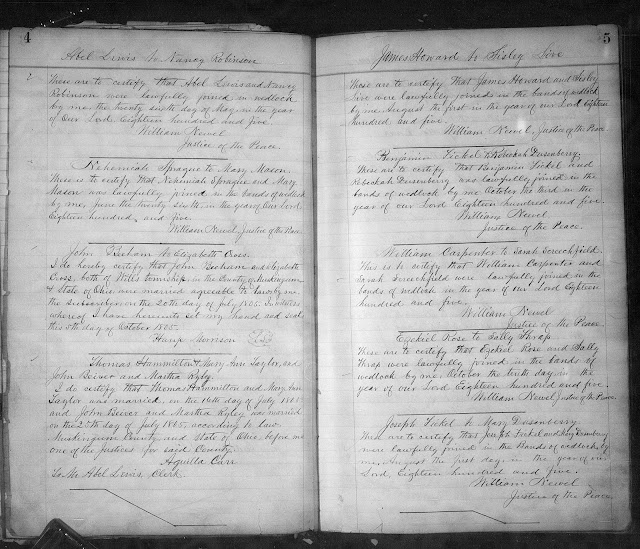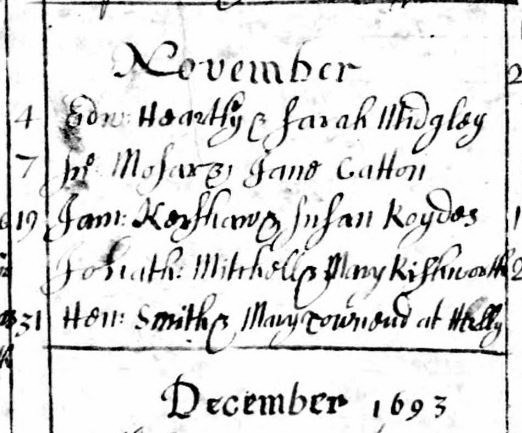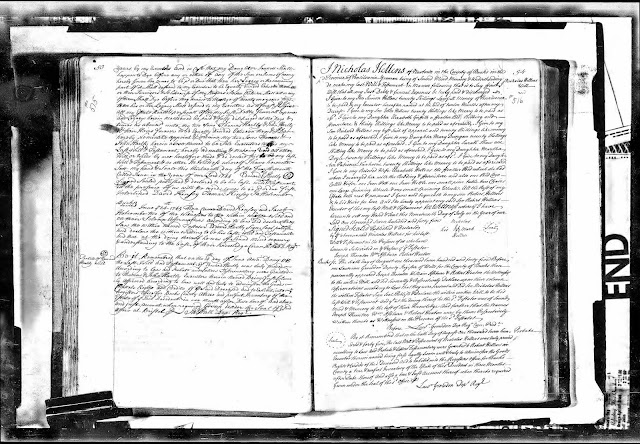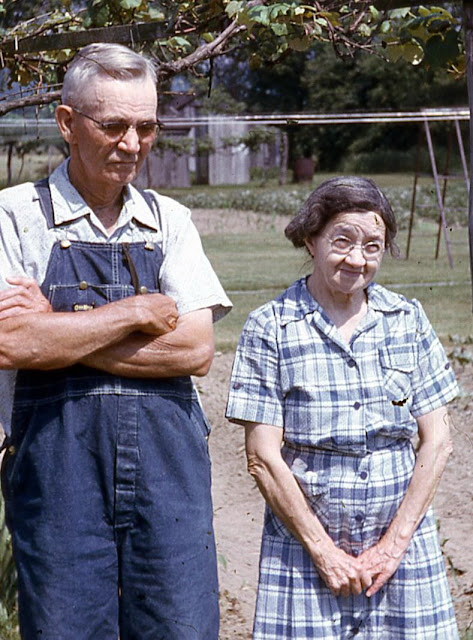Ada Hartley’s mother was Phoebe Sprague. It’s interesting that the grandmother that
raised Clarence Goldsberry, Ada’s husband, was also named Phoebe. And there are more Phoebes in this line!
Phoebe Emaline
Sprague was born December 18, 1858 in Athens County, OH. She married Samuel Hartley in 1876. They lived next door to her parents in the
1880 Census, in Canaan Township, Athens County.
By 1890, they were living in Lodi Township, where they continued to live
until their deaths. Samuel and Phoebe
are buried at Graham Chapel Cemetery.
Phoebe Sprague Hartley's death certificate naming her father as Harmon Sprague and
her mother as Elvira Bobo.
Sprague Family has played an integral part in the history of the state of Ohio
and the nation. I have spent hours
researching this family, with my husband and sister’s help, and still have more
to do! I hope to complete an application
for the Daughters of the American Revolution based on this family, but am still
needing one piece of documentation. We
are heading to Missouri this summer to look for records there.
I would
encourage all my family members to read Sprague Families in America by Warren
Vincent Sprague to understand the fascinating story of the Spragues. It is available online. The author was from Athens County, was a
cousin of our ancestors, and spent years researching and interviewing for the
book.
Phoebe
Sprague Hartley’s father was Harmon Sprague.
Harmon and his wife have about made me tear my hair out with their name
variations! Harmon was also called
Hiram. His wife’s name is sometimes
written as Almira and sometimes Elvira.
I have joked that they must have either been terrible spellers or they
had really bad speech defects that caused other people to write their names
differently each time!
Harmon
was born October 23, 1828 in McConnellsville, Morgan County, Ohio. He was the son of Isaac Sprague and Phoebe
Elizabeth Hedden, but I cannot find a single legal document to substantiate
that. Birth records were not yet
required when he was born, and I checked the Court House records in Morgan
County to no avail. The aforementioned book,
Sprague Families in America, states that Harmon is the son of Isaac, but the
DAR does not look at published genealogies as a definitive source. His parents moved to Canaan Township, Athens
County, Oh sometime after the 1830 census and before the 1850 Census. In the 1850 Census, Harmon is living with his
two older brothers, next door to their parents, making it impossible to use
that census to prove the father/son relationship of Isaac and Harmon.

Harmon
married Irena Blakely on April 6, 1851 in Athens County. The Blakely Family keeps popping up in my
family tree. There were three Blakely
sisters. Irena married into my paternal
grandmother’s line, Caroline married into my Robinson Family on my mother’s
side, and Adeline Blakely married into my mother’s Phillips Family.
Marriage record of Harmon Sprague and Irena Blakely
Soon after his marriage to Irena, Harmon, his
parents, and his brothers went to work on the railroad in Illinois. Working conditions were terrible. The tracks often went through very swampy
land. Workers and their families were
often victims of malaria, dengue, and cholera.
Irena died in Illinois, though I have not been able to find any record
of her death, and Harmon was close to death.
Harmon knew several doctors back in Athens County who were related to
him, and rode back to Athens on the train to get treatment. The treatment was successful, and Harmon
recovered, but he decided to stay in Athens instead of joining the rest of his
family moving further west with the railroad.
Harmon
married for the second time Almira/Elvira Bobo on August 21, 1856 in Athens
County. Phoebe was born about two years
later.
Marriage record of Harmon Sprague and Almira Bobo
The family lived in Lodi Township
until sometime before the 1870 Census, when they were living in Canaan
Township, where they lived until their deaths.
Harmon and Almira are buried in Graham Chapel Cemetery. Almira died in 1903. Harmon spent the next four years talking to
his grandson, John Sprague, about his family’s history, his Christian testimony,
and the many revivals which took place at Graham Chapel. Harmon died in 1907. Harmon and Almira’s graves were marked only by
peony bushes for many years, until a descendant named Budd Sprague (John
Sprague’s nephew) purchased a marker for them.
Budd told me several neighbors from around the church came to the
cemetery while the marker was being placed to tell him what wonderful people
Harmon and Almira were. Budd Sprague has
written down the memories which his Uncle John shared with him, and I was
fortunate to read through them.

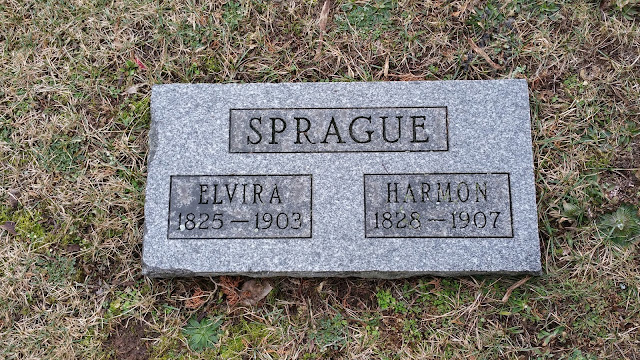
Harmon’s
parents were Isaac and Phoebe Tyler Hedden (a widow with children when Isaac married
her). Isaac was born March 1, 1797 in
Coal Run, Washington County, Ohio, before Ohio was a state. His mother died when he was a little boy, and
he was probably only 14 when his father died.
He spent most of his time with his Uncle Jonathan Sprague, who was
closest in age to Nehemiah. Isaac’s
grandfather, Joshua Sprague, left him land in Franklin County, Ohio. I have read that it was in the Brice Road
area. Joshua had been given the land in
the “Refugee Tracts” for serving the Revolutionary cause, and having been
banished from Canada. Joshua probably
gave it to Isaac in order to help him get started, since Isaac’s father,
Nehemiah, had died while Isaac was young.
Refugee Land Grant to Isaac Sprague
Isaac married Phoebe Elizabeth (Tyler)
Hedden in McConnellsville, on December 26, 1823. Phoebe was a widow of John Hedden. They lived
in McConnelsville for several years, with Isaac running the ferry there.
Marriage record of Isaac Sprague and Phoebe Hedden
The 1830 census shows them as living in
Morgan Township in Morgan County with their three children and three other
children between the ages of 10 and 15, which were probably Phoebe’s children
from her previous marriage. They moved
to Canaan Township, Athens County, OH in 1840 and lived there until at least
1850, but then moved to Decatur, Iowa before 1860 and Speedwell, St. Clair
County, MO before 1870. Isaac died in
Lebeck, Cedar County, MO on November 12, 1876.
Lebeck is no longer a town, and is about two miles north of Cedar
Springs. There are no records of where
he is buried. I am hoping to search
court house records this summer to see if I can find any records of his estate.
Isaac’s
father was Nehemiah Sprague. Nehemiah
was born in 1770 in Sackville, Nova Scotia.
His family moved back to Rhode Island when he was six years old, then
moved again to Adams, Massachusetts. He
stayed in Massachusetts with his mother and siblings in 1788 when his father
and two older brothers, William and Jonathan, left for Marietta. He did not go when his father came back for
the rest of the family in 1789, but was in Marietta by 1790 and lived in Fort
Frye during the Indian troubles.
On March 11, 1791, Nehemiah’s
younger brother, Wilbur, left the fort before daylight to do his chores on the
family property. He was shot by a group
of Indians as he headed back to the fort.
He was hit in the hip. Nehemiah
and older brother Jonathan ran out of the fort amid a shower of bullets to
bring Wilbur back into the fort. Wilbur
was crippled for the rest of his life.
On another occasion, Indians attacked
Jonathan, Nehemiah, and two other boys right outside the fort. The Indians captured one of the other boys,
Daniel Convers, who was taken to the Indian village in Detroit. He escaped and finally returned to Marietta
almost three years later. He said he was
always treated very well by the Indians.
An Indian bullet grazed Jonathan during this skirmish, leaving seven
holes in his shirt because of the way it hung in folds.
Nehemiah married first Mary Lowe, who is supposed to have been born in
Adams Township, Washington County, OH in 1780. They had five children. After
she died, he married Mary Mason, daughter of William and Rebecca Sharp Mason,
who came to Ohio in 1797. They had three children, the youngest who was born
four months after Nehemiah died.
Marriage record of Nehemiah Sprague and Mary Mason
Nehemiah was a farmer, and his farm
on the Muskingum River was known as the “Ridgeway Farm.” It was not far from
his brother Jonathan’s farm. Nehemiah had five children by his first wife and
three by his second. Isaac, our direct
line ancestor, was the firstborn son of his first wife. Nehemiah died in Coal Run, Washington County,
OH on February 2, 1811, only 41 years old. The story has been handed down that
Nehemiah came across a young boy traveling down the river who was very
ill. Nehemiah took care of him, even
after discovering that the boy was sick from smallpox. He cared for the boy himself to keep from
spreading the disease to anyone else.
The boy died, and Nehemiah buried him immediately, hoping to prevent
spreading the disease. However, Nehemiah
had already contracted the disease and died soon after. His grave is in the Devol Cemetery, close to
the Jonathan Sprague home on Muskingum River Road. Also in this cemetery is Wilbur Sprague’s
grave, Nehemiah’s younger brother who was wounded by the Indians.

The Devol Cemetery
Nehemiah’s
father was Joshua Sprague, a Revolutionary War soldier, who was born July 3,
1729 in Smithfield, Rhode Island. On
April 22, 1750, Joshua married Amy Darling first, then Abigail Wilbur. He immigrated to Nova Scotia in 1762. Land was made available in Canada when the
French Arcadian were driven out by the British during the French-Canadian
War. The Sprague family took up a
homestead of several hundred acres at the town of Sackville, and lived there
for about 14 years, but was driven out by the British when hostilities began
with the American colonies. Joshua and
his family had to leave with only the clothes on their backs. They returned
first to Rhode Island, then to Massachusetts.
Joshua
enlisted as a private in Col. Archibald Crary’s Regiment in 1776, when he was
47 years old. In Massachusetts, he
served as a Major in Colonel Joab Stafford’s Company and fought in the battle
of Bennington on August 16, 1777. He
marched to Fish Kill on June 6, 1778 to serve in Colonel Diamond’s Regiment,
but was rejected as unfit for service.
But then, in October, 1779, he enlisted as a private in Captain Barne’s
Company, then Colonel Israel Chapens’ Third Regiment.
Joshua Sprague's military records state that he was six feet tall and of light complexion. Sprague Families in America states that he was of "more than ordinary strength and energy."
After the war, Joshua and his sons,
William and Jonathan, worked at the carpenter trade, building boats. They moved to Simrell’s Ferry, on the
Monongahela River, bringing their tool chest on a two-wheeled cart drawn by one
horse. Their plan was to build boats on
the river for the many people planning to migrate west. It is believed that they built the boat, the
“New Mayflower,” that carried Rufus Putnam and the first settlers in Ohio. However, when the Ohio Company arrived in
Marietta, they discovered they did not have adequate carpenters, and persuaded
Joshua and his sons to come to help build the stockade.
A model of a long boat at the Campus Martius Museum.
A life-size replica of a long boat, outside the Campus Martius Museum.
Joshua arrived in Marietta, Ohio
with two of his sons on June 22, 1788, just 6 ½ weeks after “The First
48.” Joshua, his sons Jonathan and
William, were contracted to build some of the “block houses” at Campus Martius
(for which he was paid $100). Rufus Putnam, head of the Ohio Company, lived in
one of the blockhouses. After the
trouble with the Indians settled down, most of the fort was dismantled and used
to build individual homes, Rufus Putnam added on to the blockhouse, and it is
still on its original site, with the Campus Martius museum built around it. It is possible, but not proven, that this is
the blockhouse that Joshua and his sons built.
If it is not the exact structure, it is almost identical to the one that
they built. It is not known for sure if
the Spragues built more than one of the blockhouses.
The Rufus Putnam home, added upon one of the original blockhouses of Campus
Martius. It is now inside the Campus Martius Museum, the museum having
been built around the home.
The interior of the Rufus Putnam
house includes two pieces of furniture built by Jonathan Sprague, Joshua’s
oldest son: a tilt-top table chair and a
corner cupboard. These pieces of
furniture came from Jonathan Sprague home.


In the fall, Joshua returned to his
home in Massachusetts, and in the next spring brought his family, including the
wife and children of his son William, and two of the children of his son
Elijah, who had died. In the spring of 1789, two new settlements were
established by settlers spreading out from Marietta. Nineteen families, including Joshua, William,
Jonathan and their families and Wilbur, single, are listed as those who first
made camp at Tuttle’s Run (about ½ mile east of the present town of Beverly.)
The settlers found a prairie that had been cultivated years earlier by the
Indians and were able to quickly clear it by setting fire to it. In January, 1791, Indians attacked at “Big
Bottom,” killing 12 and capturing 5.
There is a monument in Big Bottom State Park on State Route #266. The
remaining settlers immediately decided to build a fort. Fort Frye, as it was named, was a very unique
design. It was an irregular triangular
shape, with the long side of the triangle running along the river bank for
about 200 yards. There was a blacksmith
shop and two wells in the center of the yard.
It was reported that living at Fort Frye was much more enjoyable than
Campus Martius because Campus Martius was run more like a military
installation. They lived in the stockade
for seven years, until the trouble with Indians was over.

When
Joshua and his wife were older, they moved in with son Jonathan in Adams
Township. Jonathan’s home still stands,
and is one of the oldest in Ohio. It sits on top a hill overlooking the
Muskingum River in Washington County and is listed on the National Register of
Historic Places. Architectural
historians say that the house is a fine example of Federal architecture. When it was completed in 1800, it was the
first stone house to be built anywhere in Washington County. The barn was completed in 1803, and is one of
the oldest barns still standing in Ohio.

Joshua died October 1, 1816 in Coal
Run, Washington County, OH. He was 87
years old, and left 163 descendants, including nine sons. His wife, Abigail, died on December 6. 1828
at the age of 95. He is buried in the
Sprague Family Cemetery in Coal Run, Washington County, OH, close to Jonathan’s
home. Both Joshua and Abigail were said
to be tall with fair complexion. Joshua
was said to be a man of “more than ordinary strength and energy.” It is interesting that one census recorder
said he did not need to ask the last name of anyone settled in the Coal Run
area because the Spragues had such a distinctive appearance.
Joshua Sprague
Abigail, Consort (wife) of Joshua Sprague
The Sprague Cemetery, very close to the Devol Cemetery.
Jeff and I were able to visit
Campus Martius Museum in Marietta last summer, as well as the Sprague and Devol
Cemeteries. I was able to sit in the
table chair built by Jonathan Sprague, touch the corner cupboard built by
Jonathan, and see his house and barn on the banks of the Muskingum River. I met
a gentleman in the Historical Society Library who put me in touch with Budd
Sprague.
This is the view looking down to the Muskingum River from the
Sprague Cemetery. The white dot on the right is Jeff, waiting on
the road while I climbed through the weeds up to find Joshua
Sprague's grave. We had only longitude and latitude coordinates
to find the cemetery.
This summer, I am hoping to visit
the Court House and Historical Society in Missouri and find some record of
Isaac Sprague which would establish him as Harmon’s father.
It is interesting to read the
history of the settlement of Ohio, and to realize our ancestor was so
involved. In the book, History of Marietta and Washington County,
we find that the Ohio Company was a committee of men determined to settle the
frontier. They made detailed plans for
their trip into the frontier. The “First
48” settlers of Ohio were to include four surveyors, a superintendent of
surveyors, 22 men to attend the surveyors, 20 men to include six boat builders,
four home carpenters, one blacksmith, and nine common workmen. The men were furnished with one axe (for
clearing the land), one hoe (to cultivate the land), and their sustenance. They were allowed 30 pounds of personal
baggage. The men were to bring with
themselves a good small arm, bayonet, six flints, a powder horn and pouch,
priming wire and brush, half a pound of powder, one pound of balls, and one
pound of buckshot. They would be paid
four dollars per month. They were
subject to military-type command. Most
of the men were Revolutionary War veterans and were used to following
orders. The “First 48” arrived April 7,
1788. Joshua Sprague and sons arrived
there on June 22, 1788.
In 1788, George Washington said, "No colony in America was ever
settled under such favorable auspices as that which has just commenced at the
Muskingum...If I was a young man, just preparing to begin the world, or if
advanced in life and had a family to make provision for, I know of no country
where I should rather fix my habitation..."
When Marietta was first settled, there was no uniform currency. Ledgers
were usually kept in pounds, shillings, and pence, but each of the New England
colonies had their own way of determining the value. Actually payment was usually in the form of
bartering. Dollars and cents, based on
the metric system, were confusing for years for the early settlers.
The majority of the settlers were farmers, so they chose the “wide bottoms”
close to the river, which was the only highway into the territory. However, their first crop of corn was almost
all killed by an extremely early frost in the fall of 1789, which resulted in a
near famine. The settlers were always
grateful to a neighbor across the Ohio River whose crop was not affected by the
frost and was willing to share with the new settlers. In 1791, the settlers who had gone on about
40 miles north of Marietta were attacked by Indians and 12 were killed. Then the Indians lurked around Marietta,
driving off cattle, and making for some very nervous settlers. Many were ready to abandon the settlement and
return east.
There were still a few buffalo around when Joshua Sprague first came to
Ohio, as well as elk, but they disappeared soon after. There is record of a man killing six
buffaloes in the winter of 1792. Deer,
turkey, bear, panthers, wolves and wild cats were plentiful. The wolves were especially hard to keep away
from the settlers’ livestock. The river
was full of fish, and the common method of catching them was gigging with a
spear. A man gigged a pike which weighed
96 pounds, and cooked it for a 4th of July celebration in 1790.
Joshua’s
father was William Sprague II, who was born February 2, 1691 in Providence,
RI. He married Ellis (Alice) Brown on
September 16, 1714. They had six
children. By 1728 to 1731, he was made a Lieutenant in the Providence
Militia. By 1732, he was made Captain. He donated land for the first Baptist meeting
house in 1738. After Ellis died, he married a second time Mrs. Mercy (Mary)
Walling on August 26, 1744. There were
no children born to this marriage. He
died October 20, 1778 in Smithfield, RI, at the age of 88.
William
Sprague II’s father was Jonathan Sprague, born May 28, 1648 in Hingham,
Plymouth County, MA. Jonathan was named
after an older brother who had died ten months before he was born. The brother
was only six years old when he died. He
married Mehitable Holbrook on July 20, 1670 in Weymouth, Norfolk, MA. They moved to Providence, RI in 1681,
probably because of their religious beliefs.
He served as a deputy to the General Assembly, as Justice of the Peace,
and Speaker of the House of Deputies.
He worked on a committee to establish the northern boundary of the
settlement. In 1722, he wrote a long letter to three prominent Presbyterian
ministers in Massachusetts who wanted to establish a church in Providence. Jonathan was a Baptist, and failed to see the
necessity of a Presbyterian church in the settlement. The First Freewill
Baptist Church of Smithfield in Greenville, RI, traces its founding to the
Baptist church begun by the Spragues.
The church’s history states that the “first settled pastor was Elder Jonathan
Sprague.” Jonathan and Mehitable had at
least ten children. Jonathan died and is
buried in Providence County, RI.
Jonathan’s
father was William Sprague I. William
was born in 1609 in England and came with his brothers, Ralph and Richard, to
America in 1629, landing in Salem, MA.
William was the youngest of the three brothers. It is thought that they
sailed on the ship Abigail with Governor Endicott, and landed at Salem on
September 6, 1628. Soon after arriving in Massachusetts, the brothers were
commissioned by Governor Endicott of Salem to explore land beyond the
settlement, a vast forest between the Mystic River and the Charles River. The Albergeuian Indians were living there,
and the Sprague brothers worked out a peace agreement with them. That area became the town of Charlestown,
which was later absorbed into Boston.
The brothers helped found the first church in Boston.
William married Millicent Eames in
1635 in Charlestown, Suffolk County, MA.
In 1636, he and his father-in-law, obtained grants of land in Hingham
and moved there. He served as a
“Selectman,” Constable, and Collector of Town Rates. He and Millicent had at least 13 children.
Our ancestor, Jonathan, was William’s second son to be named Jonathan. The first Jonathan died the year before the
second Jonathan was born, when the first was only six years old. William died in Hingham, Plymouth County,
MA, October 26, 1675.
Record of William Sprague's Death in 1675
What a fascinating family! Hopefully, I will have more information to add to their story soon! Someday I would like to write a series of children's books based on this family.











